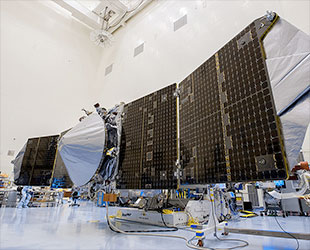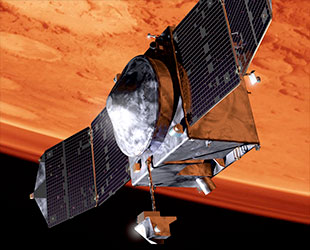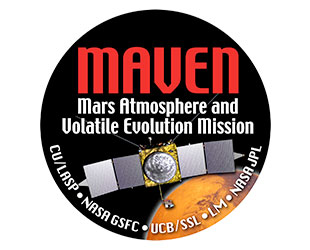November 18, 2013 — A NASA spacecraft is now hot on the trail of Mars' missing atmosphere.
MAVEN, which is short for Mars Atmosphere and Volatile EvolutioN mission, launched Monday (Nov. 18) on a ten-month interplanetary cruise to the Red Planet. Flying atop a United Launch Alliance Atlas V rocket, MAVEN lifted off at 1:28 p.m. EST (1828 GMT) from Launch Complex 41 at the Cape Canaveral Air Force Station in Florida.
NASA's 10th orbiter launched to Mars (of which three were unsuccessful) and the first mission dedicated to surveying the Martian upper atmosphere, MAVEN is set to arrive at the fourth planet from the Sun on Sept. 22, 2014. Once in orbit, the spacecraft's eight science instruments will begin one year studying what role the loss of atmospheric gas to space had in changing Mars' climate over time.
Earlier missions have shown that Mars once had a denser atmosphere, which supported liquid water on the surface. Features such as dry channels and minerals that typically form in water have provided a record of the planet's watery past, but its thin atmosphere no longer permits water to be stable at the surface.

NASA's MAVEN spacecraft is seen with its gull-wing solar panels deployed, Sept. 30, 2013. (LaunchPhotography.com/Ben Cooper) |
MAVEN will study how and at what rate Mars' atmospheric gases are being lost to space today, enabling scientists to infer what happened in the planet's past. Studying how the atmosphere was lost will lead to a better understanding of the impact that change had on Mars' climate, geologic and geochemical conditions, all of which contribute to whether Mars had an environment capable of supporting life.
The $617 million MAVEN mission will also help NASA get ready to send life to Mars.
"The MAVEN mission will provide some interesting [data] for scientists," William Gerstenmaier, NASA's associate administrator for human exploration and operations, said. "It's also good information for us on the human spaceflight front to understand how Mars' atmosphere is put together."
"[That] will be important as we look at entry, descent and landing into the Martian atmosphere with larger spacecraft than we've done before, the kind of spacecraft that were made for human missions. We will also understand what resources are available in the atmosphere and can some of those resources be used," Gerstenmaier said. "Science is pushing the way forward and we will take the data from scientific investigations and use those on the human side as well to understand the basic science activities that are occurring around Mars."

Artist illustration of NASA's MAVEN spacecraft at Mars. The real probe is set to enter Mars orbit in Sept. 2014. (Lockheed Martin) |
MAVEN's orbit around Mars will be elliptical. At its closest point to the planet, 93 miles (150 km) above the surface, MAVEN will pass through the upper atmosphere to sample its gas and ion composition directly. At its highest point, it will be more than 3,728 miles (6,000 km) high, where it will conduct ultraviolet imaging of the entire planet.
In addition, MAVEN's altitude will be lowered for five "deep dips" during the mission. In each, the spacecraft will take measurements down to about 77 miles (125 km), providing information down to the top of the lower atmosphere.
"If you [could] put your hand out when going through [the dip] you'd feel a light breeze," Guy Beutelschies, MAVEN project manager for Lockheed Martin Space Systems Co., told reporters in a pre-launch briefing. "It is really a modest amount of pressure, but it is of tremendous value to the scientists, being able to get that in situ measurement of the atmosphere."
With its two gull-wing solar panels deployed, the MAVEN spacecraft is 37.5 feet (11.43 m) from tip to tip, as long as a school bus, and weighs as much as a fully loaded SUV, 5,410 pounds (2,454 kg), including its instrument suites.
MAVEN's Particles and Fields Package uses six science instruments to characterize the solar wind, ionosphere and their interactions. MAVEN's Remote Sensing Package will determine global characteristics of the upper atmosphere and ionosphere. And the spacecraft's Neutral Gas and Ion Mass Spectrometer will be used to measure the isotopes and composition of neutrals and ions.

Insignia for the Mars Atmosphere and Volatile Evolution (MAVEN) mission to study the Red Planet's upper atmosphere. (NASA) |
In addition to its payload of science instruments, MAVEN also carries Electra, a high-frequency transceiver. Electra will serve as a backup communications relay for NASA's Curiosity and Opportunity rovers, which landed on Mars in 2004 and 2012, respectively.
The rovers are able to return more data to Earth through a relay than they could with direct-to-Earth communications. NASA's earlier-deployed orbiters Mars Odyssey and Mars Reconnaissance Orbiter currently provide the rovers' relay services.
Flying on board MAVEN to Mars is a DVD with the names of more than 100,000 members of the public, 1,100 haiku poems, and 377 examples of student artwork, all a part of the mission's educational outreach activities.
"There's quite an interest in this mission, and you wouldn't think so in that it's not as sexy as the rovers," said Omar Baez, NASA's launch director. "It's an interesting mission and it's captured the imagination."
